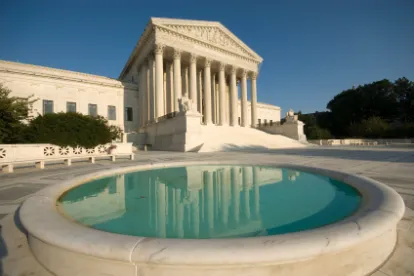During the week of 21 June 2021, the United States Supreme Court issued two decisions that ultimately remove any doubt that class representatives must present class-wide evidence of harm at the class-certification stage, regardless of overlap with merits issues. This represents the culmination of a decade’s worth of decisions that started with the court’s decision in Wal-Mart Stores, Inc. v. Dukes in 2011, the first in a line of cases establishing that would-be class representatives have an affirmative evidentiary burden under Federal Rule of Civil Procedure 23 at the class-certification stage.1 However, some federal courts remained hesitant to apply Rule 23’s full rigor and have attempted to harmonize federal precedent with a desire to avoid resolving merits issues at the class-certification stage. The two just-released decisions from the Supreme court––Goldman Sachs Group, Inc. v. Arkansas Teacher Retirement System and TransUnion LLC v. Ramirez2––should put an end to that score, particularly when the issue is evidence (or lack thereof) of class-wide harm.
Specifically, on 21 June, the court issued its decision in Goldman Sachs, which held that courts at the class-certification stage “should be open to all probative evidence … regardless of whether the evidence is also relevant to a merits question. As we have repeatedly explained, a court has an obligation before certifying a class to determine that Rule 23 is satisfied, even when that requires inquiry into the merits.”3 Four days later, the court handed down TransUnion and held that “the risk of future harm on its own does not support Article III standing for the plaintiffs’ damages claims.”4 In short, as twice stated by the court, “[n]o concrete harm, no standing.”5
Taken together, Goldman Sachs and TransUnion make clear that named plaintiffs seeking to certify a putative class cannot defer offering evidence of class-wide harm until after the class-certification stage––not only to satisfy Rule 23, but also to meet the “irreducible constitutional minimum of standing.”6 These cases continue the chorus of Dukes and Comcast before them: to certify a class action, a would-be named plaintiff must prove it at the class-certification stage, not later.
SETTING THE STAGE: DUKES AND COMCAST
Supreme Court precedent has long held that, to justify a departure from the usual rule that litigation is conducted by and on behalf of the individual named parties only, “a class representative must be part of the class and possess the same interest and suffer the same injury as the class members.”7 But only more recently in Dukes and Comcast did the court begin to establish guideposts for the quality and type of evidence that would-be class representatives must present to be successful at the class-certification stage. Initially, it is helpful to summarize Dukes and Comcast, since those cases form the foundation for Goldman Sachs and TransUnion.
-
Wal-Mart Stores, Inc. v. Dukes, 564 U.S. 338 (2011): The court reversed certification of a class of 1.5 million women employed by Wal-Mart after 26 December 1998, alleging sex discrimination in pay and promotion opportunities.8 The court held that the class representatives failed to offer class-wide proof of a common injury, which was fatal to class certification notwithstanding that the analysis “necessarily overlaps with respondents’ merits contention that Wal-Mart engages in a pattern or practice of discrimination.”9
-
Comcast Corp. v. Behrend, 569 U.S. 27 (2013): The court reversed certification of a class alleging antitrust violations related to anti-competitive behavior.10 In certifying the class, the district judge found that damages resulting from the alleged anti-competitive behavior could be calculated on a class-wide basis, which was affirmed by the Second Circuit on appeal.11 But the court held “[b]y refusing to entertain arguments against respondents’ damages model that bore on the propriety of class certification, simply because those arguments would also be pertinent to the merits determination, the court of Appeals ran afoul of our precedents requiring precisely that inquiry.”12 And, under the proper inquiry the court found that the damages “model falls far short of establishing that damages are capable of measurement on a class-wide basis.”13
In short, Dukes and Comcast set the tune that Goldman Sachs and TransUnion carried.
GOLDMAN SACHS AND TRANSUNION: FAMILIAR TUNES RE-HARMONIZED
Given Dukes and Comcast, the court’s fundamental holding in Goldman Sachs––that probative evidence on all questions impacting the class-certification analysis must be considered even if it is also relevant to a merits question––should come as unsurprising.14 But a prior precedent, Amgen Inc. v. Connecticut Retirement Plans & Trust Funds, had ostensibly muddied the waters.15 In Amgen, the court considered the previously established burden-shifting framework specific to securities-fraud class actions predicated on a fraud-on-the-market theory whereby a plaintiff may invoke a rebuttable presumption to prove reliance through evidence common to the class. To invoke what is known as the “Basic presumption,” a plaintiff must prove the following: (1) that the alleged misrepresentation was publicly known; (2) that it was material; (3) that the stock traded in an efficient market; and (4) that the plaintiff traded the stock between the time the misrepresentation was made and when the truth was revealed.16 Ultimately, the court in Amgen held that class-action plaintiffs must prove the Basic presumption’s prerequisites before class certification with one exception––that materiality should be left to the merits stage because it does not bear on Rule 23’s predominance requirement.17
With that background, the issue in Goldman Sachs was more precisely whether the defendant could rebut the materiality prerequisite of the Basic presumption at the class-certification stage (thereby shifting the burden back to plaintiffs or defeating class certification) or if materiality was purely reserved for the post-certification merits stage. Reconciling Amgen with Dukes and Comcast, the court in Goldman Sachs held that “courts should be open to all probative evidence” on all issues at the class-certification stage, “regardless whether the evidence is also relevant to a merits question.”18 After all, as the court has “repeatedly explained, a court has an obligation before certifying a class to determine that Rule 23 is satisfied, even when that requires inquiry into the merits.”19
Likewise, the court’s holding in TransUnion––that asserted risk of future harm was not a sufficiently concrete injury to confer class members standing in a suit for damages––on its face seems unremarkable.20 However, the court issued Tyson Foods, Inc. v. Bouaphakeo only five years ago, and it rejected as premature defendants’ argument that class plaintiffs’ failure to offer proof that all class members were injured was fatal to the class.21 In dicta, the Tyson Foods court remarked that
[I]t bears emphasis that this problem appears to be one of petitioner’s own making. Respondents proposed bifurcating between the liability and damages phases of this proceeding for the precise reason that it may be difficult to remove uninjured individuals from the class after an award is rendered. It was petitioner who argued against that option and now seeks to profit from the difficulty it caused. Whether, in light of the foregoing, any error should be deemed invited, is a question for the District Court to address in the first instance.22
Chief Justice Roberts concurred and, in the portion of his opinion joined by Justice Alito, responded to the majority: “Tyson’s insistence on a lump-sum jury award cannot overcome the limitations placed on the federal courts by the Constitution. Article III does not give federal courts the power to order relief to any uninjured plaintiff, class action or not.”23
With the issue of uninjured plaintiffs (or plaintiffs alleging a speculative, future injury) squarely at issue in TransUnion, the court picked up where the Chief Justice in Tyson Foods had left off. Faced with facts where the parties to a Fair Credit Reporting Act claim had stipulated that the vast majority of the class members’ at-issue credit reports had not been communicated to a third party, the court rejected the uninjured class members’ argument for standing based on an asserted risk of future harm.24 While recognizing that a plaintiff may demonstrate the “concrete injury” required to confer standing by pointing to the real risk of harm in pursuit of forward-looking, injunctive relief from occurring, the court held that the asserted risk of future harm was insufficient to confer standing in a claim for retrospective damages.25
Together, Goldman Sachs and TransUnion build on Dukes and Comcast while reconciling Amgen and Tyson Foods, which were arguably in tension. The message is clear: plaintiffs bear an evidentiary burden to satisfy Rule 23 at the class-certification stage, and district judges have an obligation to consider all probative evidence, regardless of overlap with merits issues and especially if it indicates the class would include unharmed class members.
COURTS OF APPEALS CONTINUE NOTES
Lower courts have been listening. Even before Goldman Sachs and TransUnion, evidence relevant to both class-certification and merits issues has been required to be considered at the class-certification stage, including the issue of class members’ harm (or lack thereof):
-
Olean Wholesale Grocery Coop., Inc. v. Bumble Bee Foods LLC, --- F.3d ---, No. 19-56514, 2021 WL 1257845 (9th Cir. Apr. 6, 2021):26 The Ninth Circuit reversed the district court’s order certifying classes alleging a price-fixing conspiracy by producers of packaged tuna.27 Considering whether the district court erred in not resolving conflicting expert evidence concerning the number of unharmed plaintiffs in the classes, the Ninth Circuit held that “[c]ourts must resolve all factual and legal disputes relevant to class certification, even if doing so overlaps with the merits.”28 Faced with defendants’ expert evidence that 28% of the class was unharmed and plaintiffs’ expert evidence placing that figure at 5.5% , the Ninth Circuit directed the district court to resolve the dispute given its relevance to the class-certification analysis.29 Specifically, “[i]f injury cannot be proved or disproved through common evidence, then individual trials are necessary to establish whether a particular class member suffered harm from the alleged misconduct and class treatment under Rule 23 is accordingly inappropriate.”30 Without resolving the precise percentage of unharmed class members that would defeat predominance, the court held that it must be de minimis––the outer limits of which is 5–6% ––and that 28% would unquestionably defeat predominance.31
-
In re Rail Freight Fuel Surcharge Antitrust Litig. – MDL No. 1869, 934 F.3d 619 (D.C. Cir. 2019): The D.C. Circuit affirmed the district court’s denial of class certification in putative class actions alleging price fixing.32 Plaintiffs’ damages model indicated that “2,037 members of the proposed class––or 12.7 percent––suffered … no injury from any conspiracy.”33 Noting that the available reported cases “suggest that 5% to 6% constitutes the outer limits of a de minimis number” when considering the number of unharmed plaintiffs that can exist in a certified class consistent with Rule 23, the court held that the presence of 12.7% unharmed class members––“more than twice the approximate upper bound”––defeated predominance.34
-
In re Asacol Antitrust Litig., 907 F.3d 42 (1st Cir. 2018): The First Circuit reversed the district court’s class-certification order in a case by union-sponsored benefit plans against drug manufacturers making antitrust allegations.35 At the class-certification stage, the district court found that “somewhere around 10% of the class members” were uninjured.36 Given that the district court’s class-certification order presumed that the defendant would be precluded from challenging the claims of these unharmed class members, the Second Circuit reversed.37
-
Halvorson v. Auto-Owners Ins. Co., 718 F.3d 773 (8th Cir. 2013): The Eighth Circuit reversed the district court’s class-certification order establishing a class of insureds alleging breach of contract and bad faith.38 The court held that “individual inquiries” would be necessary to determine which class members were uninjured that would “overwhelm questions common to the class,” thereby making certification improper.39
-
In re Hydrogen Peroxide Antitrust Litig., 552 F.3d 305 (3d Cir. 2008): The Third Circuit vacated the district court’s class-certification order alleging a horizontal price-fixing conspiracy.40 The court held that plaintiffs’ burden at the class-certification stage “is to demonstrate that the element of antitrust impact is capable of proof at trial through evidence that is common to the class rather than individual to its members,” and that “a district court errs as a matter of law when it fails to resolve a genuine legal or factual dispute relevant to determining the requirements.”41 Since “the District Court apparently believed it was barred from resolving disputes between the plaintiffs’ and defendants’ experts,” the Third Circuit vacated the class-certification order.42
-
Bell Atl. Corp. v. AT&T Corp., 339 F.3d 294 (5th Cir. 2003): The Fifth Circuit affirmed the district court’s denial of class certification to a putative class alleging antitrust violations.43 The Fifth Circuit held “that where fact of damage cannot be established for every class member through proof common to the class, the need to establish antitrust liability for individual class members defeats Rule 23(b)(3) predominance” and that plaintiffs’ proffered damages model could not reliably identify which class members, if any, were injured.44
CRESCENDO
The question of what stage(s) and context a defendant facing class allegations might deploy evidence of unharmed class members will be specific to the particular case. But what is clear following the Supreme Court’s decisions in Goldman Sachs and TransUnion, is that a putative class cacophony of harmed and unharmed individuals will face significant impediments to establishing standing and predominance under Rule 23.
The authors thank summer associates Nick N. Chan and Gloria O. Chibueze-Azinge for their invaluable contributions to this article.
1 See Wal-Mart Stores, Inc. v. Dukes, 564 U.S. 338 (2011); Comcast Corp. v. Behrend, 569 U.S. 27 (2013).
2 For additional analysis of the Goldman Sachs and TransUnion decisions, stay tuned for additional K&L Gates industry-focused alerts to be issued shortly.
3 No. 20-222, slip op. at 7 (June 21, 2021) (bolding added and internals omitted).
4 No. 20-297, slip op. at 26 (June 25, 2021).
5 Id. at 1, 27.
6 See Spokeo, Inc. v. Robins, 136 S. Ct. 1540, 1547 (2016) (internals omitted).
7 E. Tex. Motor Freight Sys., Inc. v. Rodriguez, 431 U.S. 395, 403 (1977) (emphasis added and internals omitted).
8 Wal-Mart Stores Inc., 564 U.S. at 342.
9 Id. at 352 (emphasis in original); see also id. (“Without some glue holding the alleged reasons for all those decisions together, it will be impossible to say that examination of all the class members’ claims for relief will produce a common answer to the crucial question why was I disfavored.” (emphasis in original)).
10 Comcast Corp., 569 U.S. at 29, 38.
11 Id. at 31–32.
12 Id. at 34.
13 Id.
14 No. 20-222, slip op. at 7 (June 21, 2021).
15 568 U.S. 455 (2013).
16 See id. at 471.
17 See id. at 466–68
18 No. 20-222, slip op. at 7 (June 21, 2021).
19 Id. (internals omitted).
20 No. 20-297, slip op. at 22 (June 25, 2021).
21 577 U.S. 442, 460–61.
22 Id. at 461–62.
23 Id. at 466 (Roberts, C.J., concurring).
24 No. 20-297, slip op. at 18–20 (June 25, 2021).
25 Id. at 20–27
26 For a deep-dive on the Bumblebee decision, see our partner Robert W. Sparkes, III’s article Something is Buzzing in the 9th Circuit: How Canned Tuna, Bumblebees, and Uninjured Class Members Combine for an Important Class Certification Ruling.
27 Bumble Bee, 2021 WL 1257845, at *1–2.
28 Id. at *4 (citations omitted).
29 Id. at *10.
30 Id. (internals omitted).
31 Id. at *11.
32 Rail Freight Fuel, 934 F.3d at 620.
33 Id. at 623.
34 Id. at 625.
35 Asacol Antitrust, 907 F.3d at 44–45.
36 Id. at 47.
37 Id. at 57.
38 Halvorson, 718 F.3d at 774–75.
39 Id. at 779.
40 Hydrogen Peroxide, 552 F.3d at 307.
41 Id. at 311–12, 320.
42 Id. at 325.
43 Bell Atl. Corp., 339 F.3d at 296.
44 Id. at 302, 308.







 />i
/>i

